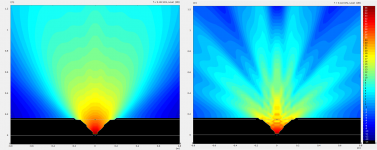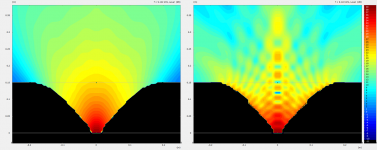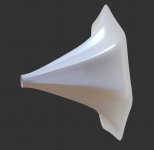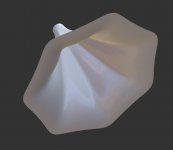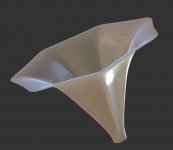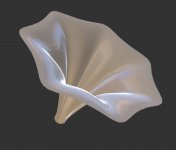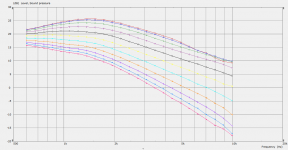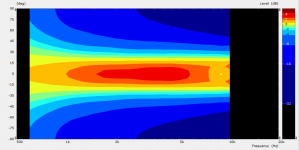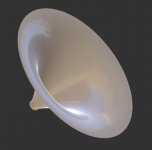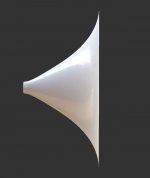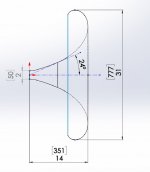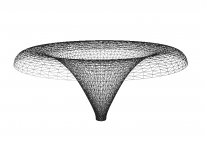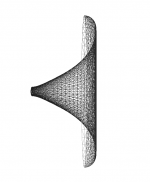I want to make some for myself but I'm still exploring possibilities. That's also why I released the tool - I hoped to see more BEM results.Are you making any of these horns? If so do you need any gene pigs for testing?
It's actually hard to decide. Too many look promising 🙂
In my view, such a tool is particularly good for making studies where you change some parameter(s) just to see the trends. By now it's obvious to me that the mouth termination is of paramount importance. The shape of cross-section may help a bit and it really seems that with a rectangular variety the beamwith control is somewhat more stable at the lower end. That is what I found so far.
Last edited:
Thanks.
Regarding actual making of the horns -
I'm still wondering what would happen if the horn would be just assembled (glued together) from many thin slices so it would make a stairwise surface. I would have a concern about one or two such discontinuities but what if there are tens of them? Has anyone ever tried to see what would happen?
Regarding actual making of the horns -
I'm still wondering what would happen if the horn would be just assembled (glued together) from many thin slices so it would make a stairwise surface. I would have a concern about one or two such discontinuities but what if there are tens of them? Has anyone ever tried to see what would happen?
Make the layers out of a soft wood and it shouldn't be a problem to fill and sand the discontinuities smooth.
Oh I would not like to do that. Just wondered what influence would it have on performace of the horn. I have no idea, really. Just in case it would be usable, I would then leave it discontinuous as it would be very easy.
I could maybe simulate that. At least give it a try.
I could maybe simulate that. At least give it a try.
I'm working on superformula for shape definition. Not sure about the merit but anyway... 🙂
It's just a different equation.
It's just a different equation.
Attachments
Last edited:
I'm working on superformula for shape definition. Not sure about the merit but anyway... 🙂
It's just a different equation.
you re an computational artist for sure 🙂
(not sure about the acoustics of this though)
when I get some free time from work I want to prototype one of the ones you posted. I have access to a super cool prototyping workshop at work.
With this tool you can easily create your own 😉...when I get some free time from work I want to prototype one of the ones you posted.
At least set the throat radius and angle to match the driver.
Last edited:
Hello Marc!
Congrats to this awesome work! I wish to have more knowledge about ABEC3 simulations in order to push my own work. A question to your small.cfg example. If I open this in ABEC3 then I see a bended interface surface that is beyond the infinite baffle plane. Why is the interface formed like a spheroid? I would have expected to see it exactly at mouth and planar?
br!
Bernd
Congrats to this awesome work! I wish to have more knowledge about ABEC3 simulations in order to push my own work. A question to your small.cfg example. If I open this in ABEC3 then I see a bended interface surface that is beyond the infinite baffle plane. Why is the interface formed like a spheroid? I would have expected to see it exactly at mouth and planar?
br!
Bernd
I actually do it as expected - see ABEC documentation regarding infinite baffle, this sub-domain boundary should be "in front" of the baffle. I'm not sure it would work being exactly in the baffle plane - I haven't tried that. It could be a cylinder (or that sort of shape) but a sperical cap is very simple to do and it proved good numerical stability. Although I didn't spend much time comparing various interfaces this one seems to work just fine, better than a cylinder in some cases.
Attachments
I'm also testing a bit deeper OS waveguides with generous mouth flares. The directivity control is still usable IMHO and the smoothes is quite good -
I'm still a little tempted to try it unbaffled but than it gets worse very quicky. I just like the looks (and the much smaller enclosure visually).
I'm still a little tempted to try it unbaffled but than it gets worse very quicky. I just like the looks (and the much smaller enclosure visually).
Attachments
Last edited:
I would most probably use that if unbaffled. For now I only do simulations for IB. Mesh modeling for a full space are still on the list...
I can generate that shape (as anyone can) but I don't have the meshing algorithm for full space sims finished yet. So I can't test now. Also the lip is now bended only to 90 deg back - I could do changes to extend it further. OK, I'm making notes in the TO-DO list.
ThroatDiameter = 50 ; [mm]
ThroatAngle = 0 ; [deg]
Coverage_Horizontal = 60 ; [deg]
Coverage_Vertical = 60 ; [deg]
Depth = 351 ; [mm]
Depth.ConicSectionPart = 0.3 ; 0.5
Shape = raw
SEExp = 2.0 ; superellipse exponent
Termination = free-air ; baffle | free-air
Termination.Scale = 0.468
Mesh.AngularSegments = 64
Mesh.DepthSegments = 30
Mesh.LipSegments = 8
ThroatDiameter = 50 ; [mm]
ThroatAngle = 0 ; [deg]
Coverage_Horizontal = 60 ; [deg]
Coverage_Vertical = 60 ; [deg]
Depth = 351 ; [mm]
Depth.ConicSectionPart = 0.3 ; 0.5
Shape = raw
SEExp = 2.0 ; superellipse exponent
Termination = free-air ; baffle | free-air
Termination.Scale = 0.468
Mesh.AngularSegments = 64
Mesh.DepthSegments = 30
Mesh.LipSegments = 8
Attachments
I would love to be able to make a custom horn design for my AMT tweeters, but then how does one go about having it physically made?
Honestly, I wouldn't bother making waveguides for AMTs. In my view, they are either too small to be really useful or they beam terribly.
- Home
- Loudspeakers
- Multi-Way
- Acoustic Horn Design – The Easy Way (Ath4)
